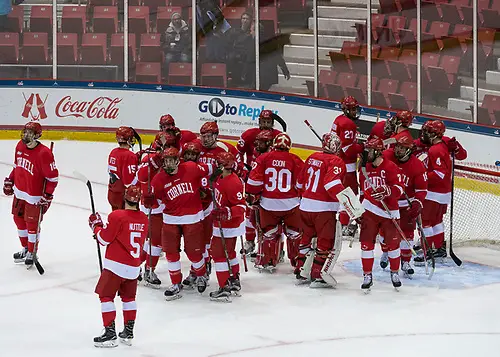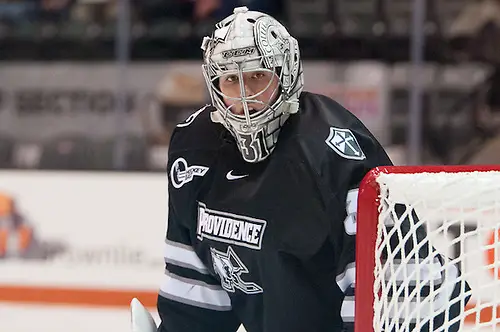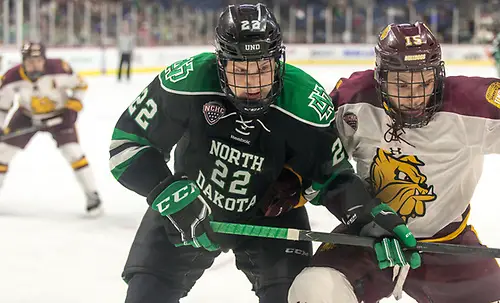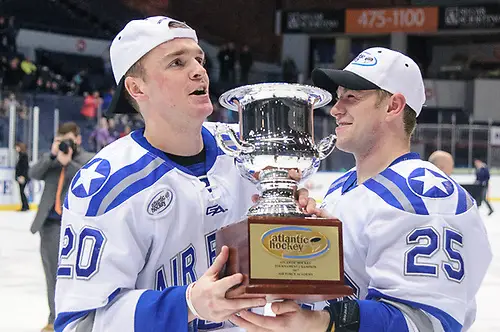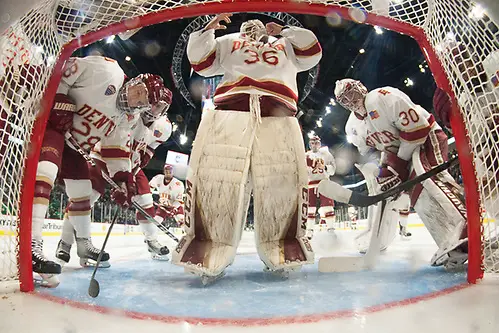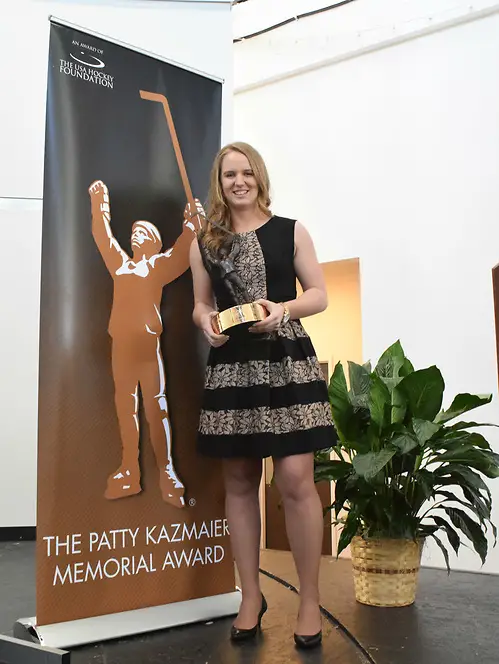It’s time for the final Bracketology of the season. Here I will predict how I think the NCAA Ice Hockey Committee will think and what the bracket will look like when it is announced.
First here is my predicted bracket and then I’ll explain how I got there afterwards:
Midwest Regional (Cincinnati):
15 Ohio State vs. 2 Minnesota-Duluth
9 Penn State vs. 6 Western Michigan
West Regional (Fargo):
16 Michigan Tech vs. 1 Denver
10 North Dakota vs. 7 Boston University
East Regional (Providence):
14 Providence vs. 3 Harvard
12 Air Force vs. 8 Union
Northeast Regional (Manchester):
13 Notre Dame vs. 4 Minnesota
11 Cornell vs. 5 Massachusetts-Lowell
Here is the top 16 of the final PairWise Rankings (PWR), and the other autobids that are not in the Top 16:
1 Denver
2 Minnesota-Duluth
3 Harvard
4 Minnesota
5 Massachusetts-Lowell
6 Western Michigan
7 Boston University
8 Union
9 Penn State
10 North Dakota
11 Cornell
12 Air Force
13 Notre Dame
14t Providence
14t Ohio State
14t Boston College
26 Michigan Tech
Autobids:
Atlantic Hockey: Air Force
Big Ten: Penn State
ECAC Hockey: Harvard
Hockey East: Massachusetts-Lowell
NCHC: Minnesota-Duluth
WCHA: Michigan Tech
Step one
From the committee’s report, choose the 16 teams in the tournament.
We break ties in the PWR by looking at the individual comparisons among the tied teams, and add in any highest seeds left that are not currently in the top 16. The only team that is not is Michigan Tech.
From there, we can start looking at the ties and bubbles in a more detailed fashion.
The ties and bubbles consist of Providence, Ohio State and Boston College at 14.
We break all of our ties based upon the RPI.
Therefore, the 16 teams in the tournament, in rank order, are:
1 Denver
2 Minnesota-Duluth
3 Harvard
4 Minnesota
5 Massachusetts-Lowell
6 Western Michigan
7 Boston University
8 Union
9 Penn State
10 North Dakota
11 Cornell
12 Air Force
13 Notre Dame
14 Providence
15 Ohio State
16 Michigan Tech
Step two
Now it’s time to assign the seeds.
No. 1 seeds: Denver, Minnesota-Duluth, Harvard, Minnesota
No. 2 seeds: Massachusetts-Lowell, Western Michigan, Boston University, Union
No. 3 seeds: Penn State, North Dakota, Cornell, Air Force
No. 4 seeds: Notre Dame, Providence, Ohio State, Michigan Tech
Step three
Place the No. 1 seeds in regionals.
No. 1 Denver is placed in the Midwest Regional in Cincinnati.
No. 2 Minnesota-Duluth is placed in the West Regional in Fargo.
No. 3 Harvard is placed in the East Regional in Providence.
No. 4 Minnesota is placed in the Northeast Regional in Manchester.
Step four
Now we place the other 12 teams so as to avoid intra-conference matchups if possible.
Begin by filling in each bracket by banding groups. Remember that teams are not assigned to the regional closest to their campus sites by ranking order within the banding (unless you are a host school, in which case you must be assigned to your home regional).
If this is the case, as it was last year, then the committee should seed so that the quarterfinals are seeded such that the four regional championships would be played by No. 1 vs. No. 8, No. 2 vs. No. 7, No. 3 vs. No. 6 and No. 4 vs. No. 5.
So therefore:
No. 8 Union is placed in No. 1 Denver’s regional, the Midwest Regional.
No. 7 Boston University is placed in No. 2 Minnesota-Duluth’s regional, the West Regional.
No. 6 Western Michigan is placed in No. 3 Harvard’s regional, the East Regional.
No. 5 Massachusetts-Lowell is placed in No. 4 Minnesota’s regional, the Northeast Regional.
No. 3 seeds
Our bracketing system has one regional containing seeds 1, 8, 9, and 16; another with 2, 7, 10 and 15; another with 3, 6, 11 and 14; and another with 4, 5, 12 and 13.
As a host school, we place North Dakota first.
No. 10 North Dakota is placed in No. 7 Boston University’s regional, the West Regional
No. 9 Penn State is placed in No. 8 Union’s regional, the Midwest Regional.
No. 11 Cornell is placed in No. 6 Western Michigan’s regional, the East Regional.
No. 12 Air Force is placed in No. 5 Massachusetts-Lowell’s regional, the Northeast Regional.
No. 4 seeds
One more time, taking No. 16 vs. No. 1, No. 15 vs. No. 2, etc.
No. 16 Michigan Tech is sent to No. 1 Denver’s regional, the Midwest Regional.
No. 15 Ohio State is sent to No. 2 Minnesota-Duluth’s regional, the West Regional.
No. 14 Providence is sent to No. 3 Harvard’s regional, the East Regional.
No. 13 Notre Dame is sent to No. 4 Minnesota’s regional, the Northeast Regional.
The brackets as we have set them up:
Midwest Regional (Cincinnati):
16 Michigan Tech vs. 1 Denver
9 Penn State vs. 8 Union
West Regional (Fargo):
15 Ohio State vs. 2 Minnesota-Duluth
10 North Dakota vs. 7 Boston University
East Regional (Providence):
14 Providence vs. 3 Harvard
11 Cornell vs. 6 Western Michigan
Northeast Regional (Manchester):
13 Notre Dame vs. 4 Minnesota
12 Air Force vs. 5 Massachusetts-Lowell
Our first concern is avoiding intraconference matchups. We have none.
Now, we turn our attention to attendance.
We turn towards bringing eastern teams back towards the east and western teams towards the west.
Looking at the second and third bands, we want to bring Union east, Western Michigan to the west. How can we do this?
We swap the two teams.
Midwest Regional (Cincinnati):
16 Michigan Tech vs. 1 Denver
9 Penn State vs. 6 Western Michigan
West Regional (Fargo):
15 Ohio State vs. 2 Minnesota-Duluth
10 North Dakota vs. 7 Boston University
East Regional (Providence):
14 Providence vs. 3 Harvard
11 Cornell vs. 8 Union
Northeast Regional (Manchester):
13 Notre Dame vs. 4 Minnesota
12 Air Force vs. 5 Massachusetts-Lowell
But what we’ve done is create and All-ECAC matchup in Providence. So we should move Cornell to Manchester.
Midwest Regional (Cincinnati):
16 Michigan Tech vs. 1 Denver
9 Penn State vs. 6 Western Michigan
West Regional (Fargo):
15 Ohio State vs. 2 Minnesota-Duluth
10 North Dakota vs. 7 Boston University
East Regional (Providence):
14 Providence vs. 3 Harvard
12 Air Force vs. 8 Union
Northeast Regional (Manchester):
13 Notre Dame vs. 4 Minnesota
11 Cornell vs. 5 Massachusetts-Lowell
So that’s it, the bracket.
Or is it?
I am looking at the big old Ohio State playing in Ohio. That is too good to pass up from an attendance standpoint, especially when Fargo is sold out and Cincinnati might get more seats with Ohio State there.
I make a swap.
Midwest Regional (Cincinnati):
15 Ohio State vs. 2 Minnesota-Duluth
9 Penn State vs. 6 Western Michigan
West Regional (Fargo):
16 Michigan Tech vs. 1 Denver
10 North Dakota vs. 7 Boston University
East Regional (Providence):
14 Providence vs. 3 Harvard
12 Air Force vs. 8 Union
Northeast Regional (Manchester):
13 Notre Dame vs. 4 Minnesota
11 Cornell vs. 5 Massachusetts-Lowell
Take a look at BU and Union swapping. Is there a benefit there? Not in my eyes.
So that’s my bracket.
The conference breakdown:
Hockey East — 4
NCHC — 4
Big Ten — 3
ECAC Hockey — 3
Atlantic Hockey — 1
WCHA — 1
We’ll see how the committee does it tomorrow.
